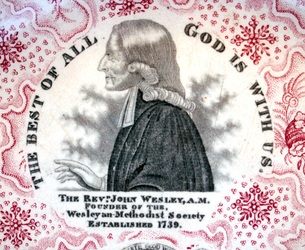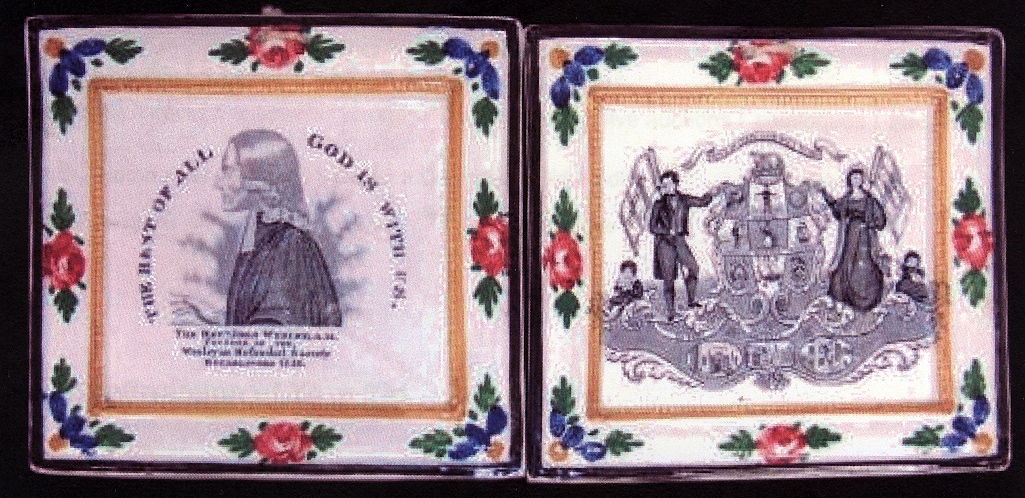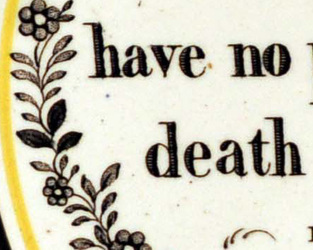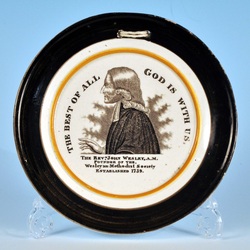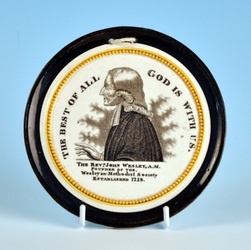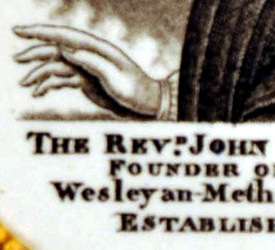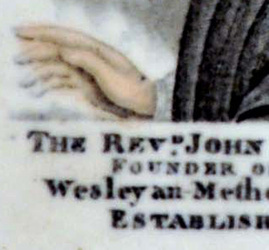|
5/30/2012 1 Comment Another Sheriff Hill plateI cannot tell you how excited I was to receive the photos of the plate below. Thanks to Michael Horsburgh for sharing them. The plate has the Sheriff Hill Wesley transfer, with 'FOUNDER OF THE' in the title, above a Tee Total transfer. Even better, the plate has a J & P impressed mark (below left) for Jackson and Patterson of the Sheriff Hill Pottery, Gateshead, 1830–45. If you look at the detail of the Wesley transfer (below right) it has the distinctive flaws in the letter 'N' of 'JOHN' and the 'M' of 'Methodist' that I blogged about recently. Last year I wrote a post on the variations of Tee Total transfers. As we'd hope, this variation of the transfer appears on plaques I've attributed to Sheriff Hill (see below). I always felt slightly uncomfortable hanging a whole raft of attributions on a single plate. We now have two marked plates, and a second transfer. There's still the possibility that Sheriff Hill supplied plain earthenware, marked J & P, to Maling for decoration, but I now feel it's less likely. N.B. I have no knowledge of this Tee Total transfer appearing on Maling items. The plate strengthens the Sheriff Hill attribution for the many small distinctive plaques made in the 1830s and 40s. I've been asking around about the red transferred pattern that appears as a background. Thanks to Steven Moore who writes: The red part is called a 'sheet pattern" and multicoloured printing was popular 1840s -50s. I have seen Sewell pieces with bi coloured printing before. Sheet patterns were cheaper to produce and were printed on rollers and could be adapted to any shape. I wonder whether anyone else has objects with this particular sheet pattern? Particularly in combination with transfers I've attributed to Sheriff Hill.
1 Comment
Please read my previous blog post first. Thanks to the high resolution photo (third below) on Boldon Auctions website, I think we can prove that the Sheriff Hill attributed plaques (first two plaques below), and the Robert Maling attributed plaques (third plaque below), share transfers from the same copper plate. Note the 'd' in 'death' in particular. The problem is that Robert Maling (mark used 1830–40) and Jackson & Patterson (mark used 1830–1845), were in operation at the same time. If anyone out there has any clues to the links between the two potteries please get in touch. P.S.I should mention that the orange plaques, like the one below, attributed to Ball's Deptford Pottery come from different transfer plates. The punctuation of the verse is different (N.B. no full stop after 'GOD'). I've transcribed the differences on the Other scripture verses page. Another puzzle... Balls were renowned for recycling other factories' transfers. Yet I don't know of this version of the transfer appearing anywhere else.
5/6/2012 0 Comments The 'Sheriff Hill' WesleyIt was a delight to see the plate below 'in the flesh' this weekend, and to get some high resolution photos. The impressed mark 'J.&P' is for Jackson and Patterson of the Sheriff Hill Pottery, Gateshead, 1830–45 (N.B. R C Bell's 'Tyneside Pottery' book states the firm was run by Jackson & Patterson 1833–8, but records in the Sunderland Museum say 1830–45). Those who know this site well will have seen that I've hung a whole raft of attributions on this one marked plate. So is the transfer on the plate the same as that on the unmarked plaques below? I now feel certain that it is. Look at the details on the right. In particular, the letter 'N' in 'JOHN'. The top right of the letter is infilled – a flaw in the transfer that repeats on all the plaques below. Note also the heavy left foot of the 'M', in Methodist. Again this flaw appears on all of the plaque transfers. So could life really, for once, be that simple? I'm afraid not. The first very small fly in the ointment is the plaque below. The 'N' in 'JOHN' is not infilled. However, judging by the very poor imprint (which I've darkened in Photoshop), I'd say this plaque was produced a decade or so later than those above. N.B. see a similar plaque dated 1846 on the Sheriff Hill page. I believe wear of the transfer plate accounts for this difference. There are still traces of the heavy foot in the 'M' of Methodist. So far so good. But look at this... A Wesley plaque in the Willet Collection, Brighton and Hove Museums. I've asked for a better photo, but with 'FOUNDER OF THE' in the title, this is clearly the Sheriff Hill Wesley, but on a plaque form more commonly associated with Robert Maling. This perhaps shouldn't come as a surprise to anyone who remembers me posting Jim Railton's old catalogue entry below. 'FORGIVE, and ye shall be FORGIVEN' is a verse that also appears on plaques I've attributed to Sheriff Hill. The marked Sheriff Hill plate above has a lovely crisp transfer. So it seems likely the transfer plate started its life there. But at what point did it, and the verse transfer plates, find their way to Maling? Or did Sheriff Hill supply a batch of plain earthenware plates, with the 'J.&P' mark, to Maling for decoration? In which case all the plaques would be Maling, and not Sheriff Hill. Or perhaps Maling copied the Sheriff Hill transfers, so the plaques come from different transfer plates? We'll know a bit more when I receive a better image.
|
AuthorStephen Smith lives in London, and is always happy to hear from other collectors. If you have an interesting collection of plaques, and are based in the UK, he will photograph them for you. Free advice given regarding selling and dispersal of a collection, or to those wishing to start one. Just get in touch... Archives
February 2022
AcknowledgementsThis website is indebted to collectors, dealers and enthusiasts who have shared their knowledge or photos. In particular: Ian Holmes, Stephen Duckworth, Dick Henrywood, Norman Lowe, Keith Lovell, Donald H Ryan, Harold Crowder, Jack and Joyce Cockerill, Myrna Schkolne, Elinor Penna, Ian Sharp, Shauna Gregg at the Sunderland Museum, Keith Bell, Martyn Edgell, and Liz Denton.
|



